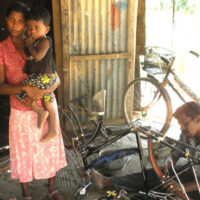Doing the Right Things for the Wrong Reasons? The Family Background Report and Migrant Women
By Chandima Arambepola | Senior Research Professional
The cabinet decision last month to ease the Family Background Report regulation imposed on all women who wish to work overseas, has been received with elation and consternation in equal parts. In place since 2013, the FBR restricted women’s ability to migrate but placed serious limitations on women’s fundamental rights to choose work and make decisions pertaining to her life and that of her family. While women with children under two years will continue to be banned from migrating, the decision marks an important reversal of a regressive and counter-productive policy decision taken in haste. But it continues to raise questions about Sri Lanka’s ability to extend support to all migrant workers and their families.
………………………………
Why was the FBR introduced?
Following the execution of the under-aged Rizana Nafeek in Saudi Arabia in 2013, the FBR was seen to quell the public furore over the failure of the Government of Sri Lanka to stay her execution. Introduced without wider consultation, the FBR was perceived by a larger segment of the public and media as a positive step to stop families from breaking down in the absence of the mother. Despite international protests and action by some civil society organisations in Sri Lanka, the regulation gained strength from a Cabinet paper submitted by the Ministry of Women and Child Affairs in 2007 to ban women with children under the age of 5 years from working overseas. While the regulation has undergone much change over the years, earlier versions were highly discriminatory. For instance, unmarried women had to prove they had no children and initially, required the permission of their parent to migrate. Similarly, married women required their husband’s permission and could only appoint a close female relative as the guardian of the children, even when the father was present. The presence of a differently-abled child, even an adult, was grounds for refusal of the FBR. Women’s private lives came under microscopic scrutiny of government officials from the Grama Niladhari and Development officers to Principals and teachers who could subjectively determine, her suitability to migrate.
Did it work?
The study on the impact of the FBR conducted by the Centre for Poverty Analysis (CEPA) for the International Labour Organisation, found that it failed to meet its basic tenants. Rather than stop women from migrating, a thriving alternative migration structure arose to facilitate women to circumvent the ban. While official numbers showed a decline, women continued to migrate by remaining invisible. This however, raised genuine fears of a rise in human trafficking and the women’s safety overseas as well as the extent to which they could be supported by the Sri Lankan government. Corruption and bribery and being at the mercy of intermediaries, agents and officials further complicated the process for women, increasing the risks of abuse in the pre-departure phase. Furthermore, instead of supporting the left-behind children, the government officers spent over 90 percent of their time administering the regulation. Ironically, it cast the women and their children outside of the protection mechanisms in place.
Equally worrying was the class and gender hierarchies and the power relations underlining the FBR. The poorer, semi-skilled women who sought work as domestic or apparel sector workers by using registered recruitment agencies were disproportionately targeted. In contrast, middle-class women were considered to be better mothers, capable of making the “right” decisions and choices and remained largely outside of the regulation Wresting the power to make decisions about their families’ wellbeing, poorer women were cast as incapable and bad mothers with a selfish need to migrate at all costs. In addition, despite Sri Lanka’s law recognising both parents as equal guardians of the children, fathers were framed as incapable of looking after the children and were generally treated with suspicion and as potential abusers.
The FBR also failed to recognise long-standing problems in women’s access to meaningful support from existing service structures. First, regardless of marital status and the presence of children, economic hardships compounded by the lack of sustainable and alternative livelihood opportunities compel women’s migration. It is also an escape route from violent homes and abusive partners especially when existing protection and service structures fail to offer comprehensive support. When the regulated gates closed with no alternatives offered, women used the less safe, more riskier routes to secure such work overseas.
What can be done now?
The easing of the FBR will yet again make migration safe for women, as they can use regular channels without any fear of coercion. However, two unresolved questions require the government’s attention. Rather than framing migrant women as bad mothers and the fathers as potential abusers, focus must be placed on the protection and support for the left-behind families. The use of care plans, developed in consultation with the migrant women, is currently being used by government officials. This can be extended to men as well so that all migrant families receive support regardless of which parent is absent. The committee set up at the Divisional Secretariat office to approve the FBR can be re-formulated to identify at-risk or vulnerable families and ensure they receive the necessary support.
However, the timing of the decision sends a clear message: rather than any concern for the protection of the families or the women as workers, it is the desperate need for foreign remittances that has shaped this particular outcome. In the long run, this bodes ill for women’s rights and for migrant women, as the commitment on the part of the Government to ensure the rights of women is not a given but hinges on her capacity to return the favour.
The easing of the FBR regulation therefore, does not necessarily guarantee the state’s commitments to protect migrant workers. While the right to migrate and work must be ensured, the government must revisit its own role in ensuring that minimum standards of decent work are assured for all workers and that protection mechanisms are strengthened to support migrant workers when in need. The easing of the FBR therefore, is merely the first step in the right direction towards ensuring that women migrant workers and their families receive the due attention and care they deserve.
Photo: Mehmet Orak (Pexels)
Disclaimer: The views expressed in this article are those of the author and do not necessarily reflect the views and policies of CEPA.









